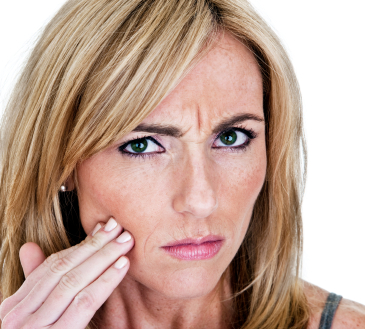Self-Care Program for TMD and Jaw Pain
Why the TM joints are particularly prone to injury
 The TM joint is a complicated, somewhat ‘wobbly’ joint well-suited for eating and speaking, but not for trauma. Most joints in the human body are held primarily together by tough fibrous tissue (joint capsule) and ligaments which connect one bone to another. They are held secondarily together by surrounding muscles and tendons. Some joints have more primary stability (fibrous tissue) like the ankle, and knee for example. These joints are made to withstand more physical stress than joints with less primary stability like the TM joint. Also, because the TM joint does not simply move in a hinge-like manner but also glides down and forward the joint capsule needs to have a lot of slack.
The TM joint is a complicated, somewhat ‘wobbly’ joint well-suited for eating and speaking, but not for trauma. Most joints in the human body are held primarily together by tough fibrous tissue (joint capsule) and ligaments which connect one bone to another. They are held secondarily together by surrounding muscles and tendons. Some joints have more primary stability (fibrous tissue) like the ankle, and knee for example. These joints are made to withstand more physical stress than joints with less primary stability like the TM joint. Also, because the TM joint does not simply move in a hinge-like manner but also glides down and forward the joint capsule needs to have a lot of slack.
Like any joint (hip, shoulder, knee) the TMJ can be sprained or injured. The injury can be the result of a specific trauma to the jaw area or can result from prolonged repetitive jaw strain, like clenching or grinding of teeth. The process of injury starts when repetitive activity fatigues a specific structure such as a tendon or bone. With sufficient recovery, the tissue adapts to the demand and is able to undergo further loading without injury. Without adequate recovery however, microtrauma develops and stimulates the body’s inflammatory response, causing the release of vasoactive substances, inflammatory cells, and enzymes that damage local tissue .Cumulative microtrauma from further repetitive activity ultimately causes clinical injury. In chronic or recurrent cases, continued loading produces degenerative changes leading to weakness, loss of flexibility, and chronic pain. Thus, in TMJ disorder, what we are most concerned about is not the acute tissue inflammation, but chronic degeneration.
Managing your jaw pain
Once a joint is strained, it can be easily re-injured (like a sprained ankle which is subsequently more prone to injury). Because we use the jaw for so many activities (talking, eating, yawning, laughing) the joint is constantly being moved. Therefore, TOTAL relaxation of the jaw joint and surrounding muscles is difficult. Holding the jaw muscles and joints in a relaxed position is, however, very manageable with practice. Regular attempts to relax the jaw muscles, and avoidance of activities that would overwork the area will be helpful to reduce the pain and prevent additional strain to the area. The following suggestions will help:
- In order to change your jaw habits you must first try and become conscious of your jaw habits and times when your jaw is strained or tense. Notice any contact your teeth make or any position your jaw returns to. Notice any clenching, grinding, gritting of teeth or tensing of jaw muscles. Notice resting your jaw on your hand. Notice biting of cheeks; biting pens, pencils or other objects; gum chewing; tongue pushing against teeth or other habits. Notice when these jaw activities occur, such as during driving, reading, social situations, conversation, fatigue, overwork, stress, or emotional upset. Also notice whether your symptoms are worse or better at any time of the day or week. Be aware of anything that makes the symptoms better or worse. Work on eliminating these habits.
- Relaxing the Jaw. Your teeth should make contact during eating and swallowing only. Otherwise your teeth should be apart and the tip of your tongue should be placed behind your lower front teeth to relax the jaw. Keep your shoulders down. Push straight down and relax. Breathe deeply from your abdomen, hold 2-3 seconds, exhale letting shoulders and jaw sag.
- Heat and Ice. Alternate between applying moist heat (20min) and ice wrapped in a thin washcloth (10min) two to four times a day to the painful area. Heat and ice both reduce joint or muscle pain and relax the muscles.
- Eat a softer diet. A softer diet places less stress on the jaw muscles and joints. Avoid foods that require a lot of chewing, such as steak. Cut food into small pieces and chew food on both sides at the same time to reduce strain on one side.
- Avoid caffeine (coffee, tea, soda & chocolate). Caffeine is a muscle contracture drug and can make your muscles tight.
- Avoid stomach sleeping, since this puts adverse forces on the jaw and neck muscles.
- Consider using anti-inflammatory medication and pain reducing medications such as Ibuprofen, Tylenol and Aspirin to reduce joint and muscle pain.